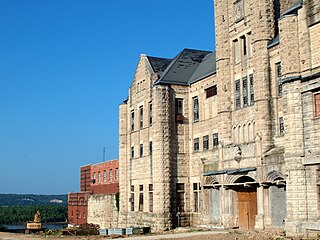
The Long Bay Correctional Complex, commonly called Long Bay, is a correctional facility comprising a heritage-listed maximum and minimum security prison for males and females and a hospital to treat prisoners, psychiatric cases and remandees, located in Malabar, Sydney, New South Wales, Australia. The complex is located approximately 14 kilometres (8.7 mi) south of the Sydney CBD and is contained within a 32-hectare (79-acre) site. The facility is operated by Corrective Services New South Wales, a department administered by the Government of New South Wales.
Auburn Correctional Facility is a state prison on State Street in Auburn, New York, United States. It was built on land that was once a Cayuga village. It is classified as a maximum security facility.

The Ohio State Reformatory (OSR), also known as the Mansfield Reformatory, is a historic prison located in Mansfield, Ohio in the United States. It was built between 1886 and 1910 and remained in operation until 1990, when a United States Federal Court ruling ordered the facility to be closed. While this facility was seen in a number of films, TV shows and music videos, it was made famous by the film The Shawshank Redemption (1994) when it was used for most scenes of the movie.
Elmira Correctional Facility, also known as "The Hill", is a maximum security state prison located in Chemung County, in the City of Elmira in the US state of New York. It is operated by the New York State Department of Corrections and Community Supervision. A supermax prison, Southport Correctional Facility, is located 2 miles (3.2 km) away from Elmira.

The New Jersey State Prison (NJSP), formerly known as Trenton State Prison, is a state men's prison in Trenton, New Jersey operated by the New Jersey Department of Corrections. It is the oldest prison in New Jersey and one of the oldest correctional facilities in the United States. It is the state's only completely maximum security institution, housing the most difficult and/or dangerous male offenders in the inmate population. NJSP operates two security units and provides a high level of custodial supervision and control. Professional treatment services, such as education and social work, are a priority at the facility. The Bureau of State Use Industries operated the bedding and clothing shops that were once located in Shop Hall at the facility. These industries have been relocated to South Woods State Prison.
Pontiac Correctional Center, established in June 1871, is an Illinois Department of Corrections maximum security prison for adult males in Pontiac, Illinois. The prison also has a medium security unit that houses medium to minimum security inmates and is classified as Level 3. Until the 2011 abolition of the death penalty in Illinois, the prison housed male death row inmates, but had no execution chamber. Inmates were executed at the Tamms Correctional Center. Although the capacity of the prison is 2172, it has an average daily population of approximately 2000 inmates.

Oregon State Penitentiary (OSP), also known as Oregon State Prison, is a maximum security prison in the northwest United States in Salem, Oregon. Originally opened in Portland 173 years ago in 1851, it relocated to Salem fifteen years later. The 2,242-capacity prison is the oldest in the state; the all-male facility is operated by the Oregon Department of Corrections (ODOC). OSP contains an intensive management wing, which is being transformed into a psychiatric facility for mentally ill prisoners throughout Oregon.
Edna Mahan Correctional Facility for Women is a prison facility for women of the state of New Jersey Department of Corrections, located in Union Township, Hunterdon County, New Jersey, near Clinton. Its official abbreviation is EMCFW. The facility was named for Edna Mahan, one of the first female correctional superintendents in the U.S.

The Massachusetts Correctional Institution at Concord (MCI-Concord) is a medium security prison for men located in Concord, Massachusetts in the United States. Opened in 1878, it is the oldest running state prison for men in Massachusetts. This prison is under the jurisdiction of the Massachusetts Department of Correction. There are 570 inmates with a total capacity of 614 general population beds.
The Pendleton Correctional Facility, formerly known as the Indiana Reformatory, is a state prison located in Fall Creek Township, Madison County, near Pendleton and about 25 miles (40 km) northeast of Indianapolis. Established in 1923, it was built to replace the Indiana State Reformatory located in Jeffersonville after a fire severely damaged the original property. The Pendleton facility currently offers maximum and minimum-security housing for adult males over 22 years old. The maximum-security portion is made up of 31 acres (130,000 m2) surrounded by a concrete wall. It has an average daily population of approximately 1,650 inmates. Located on the grounds outside the enclosure, the minimum-security dormitory holds approximately 200 prisoners on a daily basis.
The Oklahoma State Reformatory is a medium-security facility with some maximum and minimum-security housing for adult male inmates. Located off of State Highway 9 in Granite, Oklahoma, the 10-acre (4.0 ha) facility has a maximum capacity of 1042 inmates. The medium-security area accommodates 799 prisoners, minimum-security area houses roughly 200, and the maximum-security area with about 43 inmates. The prison currently houses approximately 975 prisoners. The prison was established by an act of the legislature in 1909 and constructed through prison labor, housing its first inmate in 1910. The facility is well known for the significant roles women played in its foundation and governance, most notably having the first female warden administer an all-male prison in the nation.

The Ohio Reformatory for Women (ORW) is a state prison for women owned and operated by the Ohio Department of Rehabilitation and Correction in Marysville, Ohio. It opened in September 1916, when 34 female inmates were transferred from the Ohio Penitentiary in Columbus. ORW is a multi-security, state facility. As of July 2019, 2,394 female inmates were living at the prison ranging from minimum-security inmates all the way up to one inmate on death row. It was the fifth prison in the United States, in modern times, to open a nursery for imprisoned mothers and their babies located within the institution. The Achieving Baby Care Success (ABC) program was the first in the state to keep infants with their mothers.

The Indiana Women's Prison was established in 1873 as the first adult female correctional facility in the country. The original location of the prison was one mile (1.6 km) east of downtown Indianapolis. It has since moved to 2596 Girls School Road, former location of the Indianapolis Juvenile Correctional Facility. As of 2005, it had an average daily population of 420 inmates, most of whom are members of special-needs populations, such as geriatric, mentally ill, pregnant, and juveniles sentenced as adults. By the end of 2015, the population increased to 599 inmates. Security levels range from medium to maximum. The prison holds Indiana's only death row for women; however, it currently has no death row inmates. The one woman under an Indiana death sentence, Debra Denise Brown, had her sentence commuted to 140 years imprisonment in 2018 and is being held in Ohio.

The Monroe Correctional Complex is a Washington State Department of Corrections men's prison located in Monroe, Washington, United States. With a bed capacity of over 3,100, it is the second largest prison in the state.

Minnesota Correctional Facility – St. Cloud is a state prison in St. Cloud, Minnesota, United States. Established in 1889 as the Minnesota State Reformatory for Men, it is a level four, close-security institution with an inmate population of about 1,000 men. MCF-St. Cloud serves as the intake facility for men committed to prison in Minnesota.

The Kentucky State Penitentiary (KSP), also known as the "Castle on the Cumberland," is a maximum security and supermax prison with capacity for 856 prisoners located in Eddyville, Kentucky on Lake Barkley on the Cumberland River, about 4.8 kilometres (3 mi) from downtown Eddyville. It is managed by the Kentucky Department of Corrections. Completed in 1886, it is Kentucky's oldest prison facility and the only commonwealth-owned facility with supermax units. The penitentiary houses Kentucky's male death row inmates and the commonwealth's execution facility. As of 2015 it had approximately 350 staff members and an annual operating budget of $20 million. In most cases, inmates are not sent directly to the penitentiary after sentencing, but are sent there because of violent or disruptive behavior committed in other less secure correctional facilities in the commonwealth. This was Kentucky's second penitentiary: the first was made uninhabitable from a flood in 1937.

The Union Correctional Institution, formerly referred to as Florida State Prison, Raiford Prison and State Prison Farm is a Florida Department of Corrections state prison located in unincorporated Union County, Florida, near Raiford.

The Missouri State Penitentiary was a prison in Jefferson City, Missouri, that operated from 1836 to 2004. Part of the Missouri Department of Corrections, it served as the state of Missouri's primary maximum security institution. Before it closed, it was the oldest operating penal facility west of the Mississippi River. It was replaced by the Jefferson City Correctional Center, which opened on September 15, 2004.

The State Correctional Institution (SCI) at Camp Hill, commonly referred to as SCI Camp Hill, is a Pennsylvania Department of Corrections prison in Lower Allen Township, Cumberland County, near Camp Hill in Greater Harrisburg. Its current superintendent is Laurel Harry. It has around 3,400 inmates.
The Michigan Reformatory was a state prison for men located in Ionia, Ionia County, Michigan, owned and operated by the Michigan Department of Corrections. The facility has 352 beds at Level II security and 797 beds at Level IV security.













